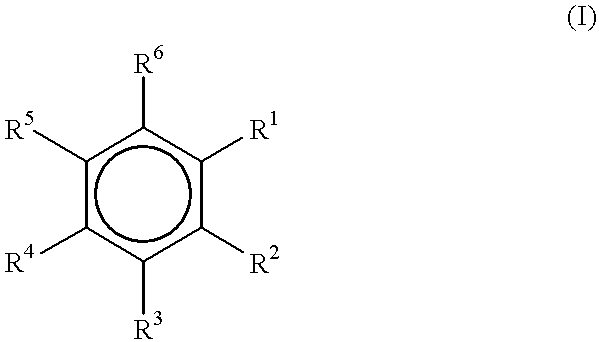Electron donors
- Summary
- Abstract
- Description
- Claims
- Application Information
AI Technical Summary
Benefits of technology
Problems solved by technology
Method used
Image
Examples
examples 8-13
Electron Donor Synthesis
The synthesis of six 1-ethoxy-2-n-alkoxybenzenes was accomplished in a one-step fashion as described above in Examples 1-7.
1-Ethoxy-2-n-propoxybenzene (I)
The reaction was conducted in a 500-ml 3-neck flask equipped with a reflux condenser, an addition funnel, and a magnetic stirring bar. Into the flask was introduced 75 ml water, 11.5 grams of 50% aqueous sodium hydroxide, 19.3 grams (0.14 moles) 2-ethoxyphenol, and 23.8 grams (0.14 moles) 1-iodopropane. The flask contents were maintained at 80.degree. C. for a period of 7 hours and were then cooled to room temperature. After the addition of 100 ml of water the reaction mixture was transferred to a 250-ml separatory funnel and washed twice with 100-ml quantities of hexane. The organic layer was washed twice with 10 ml of 15% aqueous sodium hydroxide and dried over anhydrous magnesium sulfate. Most of the solvent was removed by simple distillation. A liquid was isolated which boiled at 63-67.degree. C. @ 0.05 ...
examples 14 , 15
EXAMPLES 14, 15, AND COMPARATIVE D
Several procatalysts were prepared using the methods described above with reference to examples 8-13. The internal electron donor for inventive examples 14 and 15 were 1-ethoxy-2-n-pentoxybenzene and the procatalysts were prepared under close to optimum conditions for best polymerization performance. Comparative example D was procatalyst prepared in a manner similar to that described in U.S. Pat. No. 5,093,415 using a conventional electron donor, diisobutyl phthalate. Each of the catalysts was used in a liquid propylene stirred polymerization in a manner similar to that described above with reference to examples 8-13 with the exceptions that 0.17 mmol DCPDMS, 0.005 mmol Ti, and varying hydrogen concentrations were used. Hydrogen concentrations were varied to control MF. The results are shown in Table 4 below and in FIG. 3. These results are similar to the results that were obtained with procatalysts using of the electron donors of the present invent...
PUM
| Property | Measurement | Unit |
|---|---|---|
| temperature | aaaaa | aaaaa |
| temperature | aaaaa | aaaaa |
| temperature | aaaaa | aaaaa |
Abstract
Description
Claims
Application Information
 Login to View More
Login to View More - R&D
- Intellectual Property
- Life Sciences
- Materials
- Tech Scout
- Unparalleled Data Quality
- Higher Quality Content
- 60% Fewer Hallucinations
Browse by: Latest US Patents, China's latest patents, Technical Efficacy Thesaurus, Application Domain, Technology Topic, Popular Technical Reports.
© 2025 PatSnap. All rights reserved.Legal|Privacy policy|Modern Slavery Act Transparency Statement|Sitemap|About US| Contact US: help@patsnap.com



